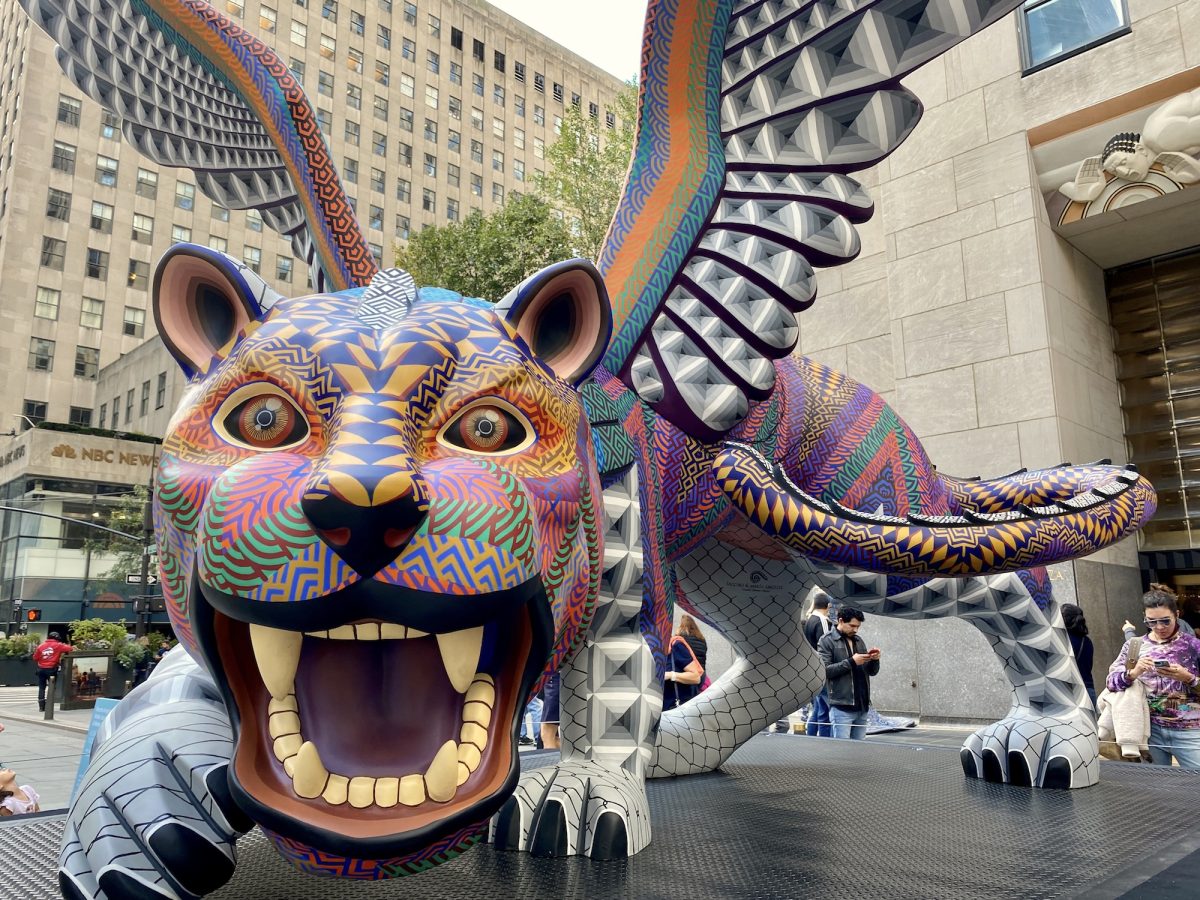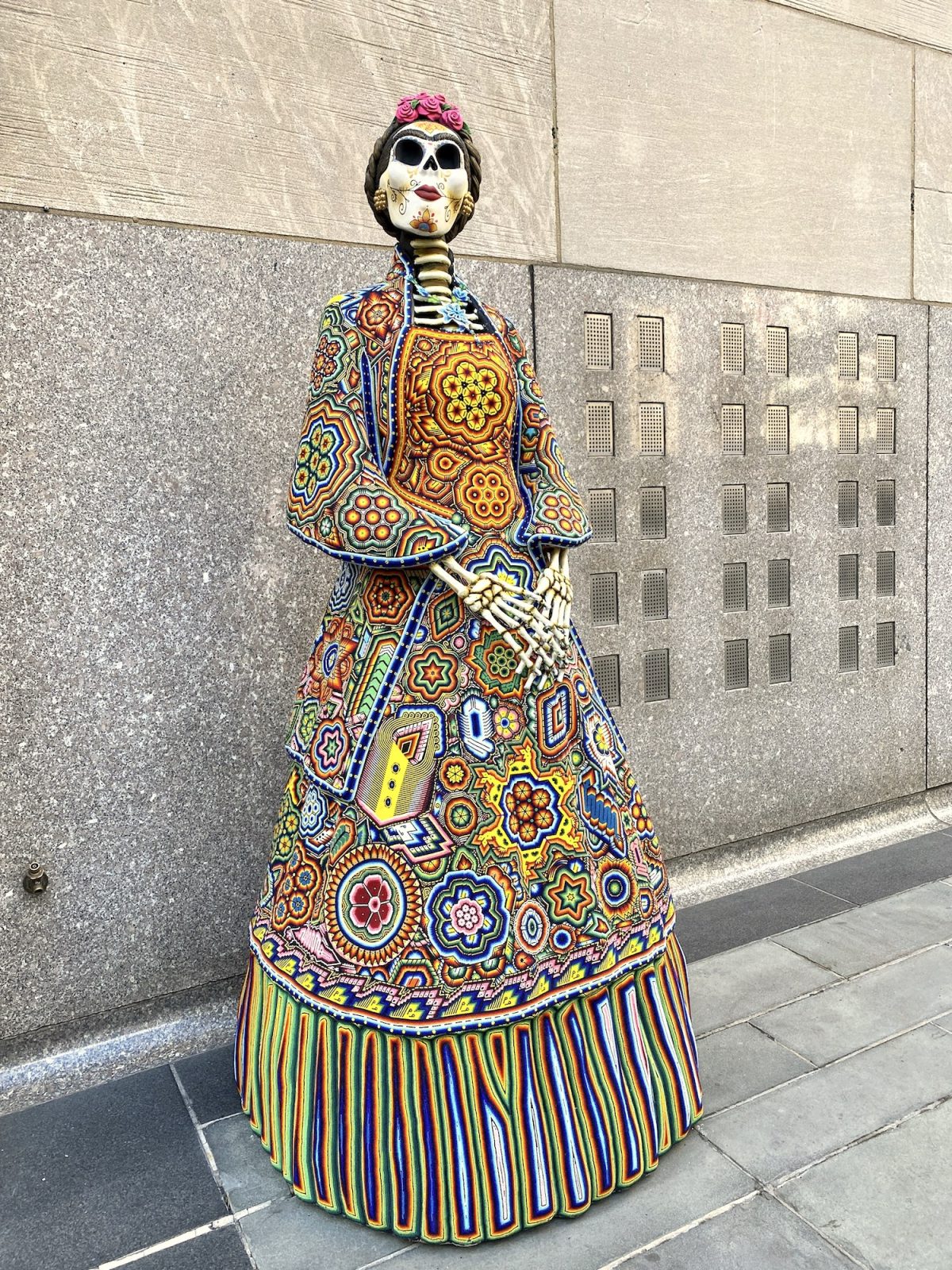

Originating thousands of years ago among the Aztec, Toltec, and other Nahua people, Día de los Muertos, or Day of the Dead, is a joyful celebration of life and death. During the first two days of November, participants create ofrendas — altars in private homes or cemeteries featuring offerings, food, family photographs, and candles to invite the souls of the dead back to the material world. Though coinciding with “spooky season” in the US, the tradition differs vastly from Halloween in its life-affirming tone and its rejection of death as a finality.

Those who want to connect with the spirit of Día de los Muertos in New York City can now visit Rockefeller Center, where a presentation of dazzling Mexican folk art will be on view starting today, October 22, through November 2. Works by Atelier Jacobo and María Angeles in Oaxaca and by Menchaca Studio, a Mexico City-based organization specializing in Huichol art and crafts, will lure city dwellers both living and incorporeal.
In the Manhattan landmark’s Center Plaza, Angeles Atelier presents two towering alebrijes, vibrantly-colored sculptures of animals and mythical creatures meant to serve as spiritual guides: an 11-foot dragon and a 13.5-foot feathered jaguar rendered in fiberglass. The first alebrijes were created in the early 1930s by Pedro Linares, an Indigenous Mexican artist, using papier mâché; in the southern state of Oaxaca, artists have continued the tradition in the medium of carved and painted wood.

The founders of Angeles Atelier, María and Jacobo, attended an unveiling ceremony today along with son and principal designer Ricardo Angeles. In an interview with Hyperallergic, the artist described his alebrijes as “guardians” for the nation’s immigrants.
“I love New York and its architecture, especially the Art Nouveau styles and the gargoyles of some buildings,” Angeles said. “I decided to create fantastical beings that also symbolized empathy and solidarity from us, the artisans who didn’t immigrate, toward our family members who are here in the United States.”
“We wanted to give them these guides to look over them, to let them know they are not alone. That’s why we included designs related to netting or frontiers, to reference the [Mexico-US] border,” he added, pointing to the dragon’s legs, which are decorated in a gray fence-like pattern.
“It’s very much a symbol of the present, mixed with my family’s very traditional symbolism,” Angeles continued.

Flanking the entrance to the famous skyscraper at 30 Rockefeller Plaza are two catrinas, skeleton figures representing the Aztec goddess Mictecacihuatl, by Menchaca Studio. The elegant skulls donning floral hats are perhaps the most recognizable symbols of Day of the Dead, inspiring the distinctive make-up, elaborate costumes, and even the pan de muerto (“bread of the dead”) found on many altars during the festivities.

“As a Oaxaqueña, I’m also Mixteca. I came here when I was 18 years old, and I think art plays an important role in activism” said Teresa Vivar, director of Lazos America Unida, a New Jersey nonprofit advocating for the Mexican American community. “It’s important to maintain our roots. Arts and culture is a way of educating the next generation and the people around us.”
Next Friday, October 29, the plaza’s iconic bronze statue of the Greek titan Atlas will be adorned with a floral installation by the New York-based flower design shop Ovando. As part of the weeklong art series, organized by the Consulate General of Mexico in collaboration with the Rockefeller Center, an open-air tianguis market will run next Friday through Sunday, October 31, showcasing the work of Mexican artisans and purveyors La Contenta, La Newyorkina, La Providencia, South Philly Barbacoa, Casa Dragones, and others.
A traditional ofrenda designed by Tónico Visual and artist Sandra Perez, replete with authentic Mexican handcrafts, will also join the sculptures to commemorate and honor the lives of those who passed due to the COVID-19 pandemic.

“In our country we have earned the recognition of our people by seeing Oaxaca as the reflection of the soul of Mexico,” said the state’s governor, Alejandro Murat Hinojosa, during today’s ceremony. “Because Oaxaca reflects the richness of our culture, our art, our history. But in another way, Oaxaca has its own soul: it has 16 Indigenous people, more than 102 dialects, and it is one of the most biodiverse states in Mexico and in the world.”
“When you think of the alebrijes, you think of the Zapotec cultures, which said before they existed in their physical form, they represented the nagual, the spirit inside of us, the purpose of life,” he continued. “By being here today with the alebrijes, we confirm our purpose.”
0 Commentaires